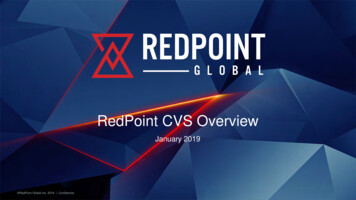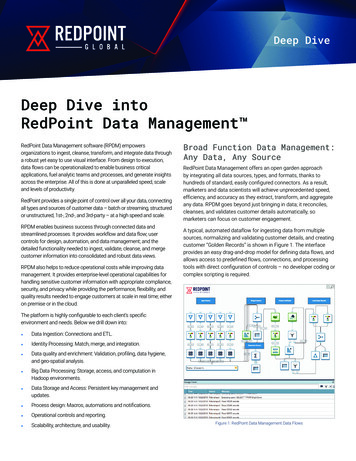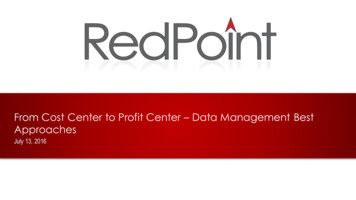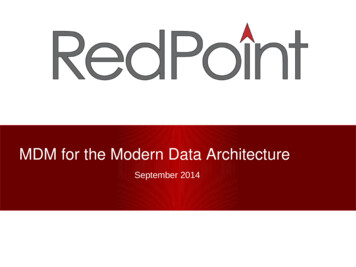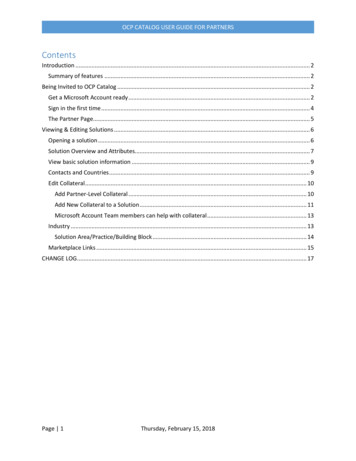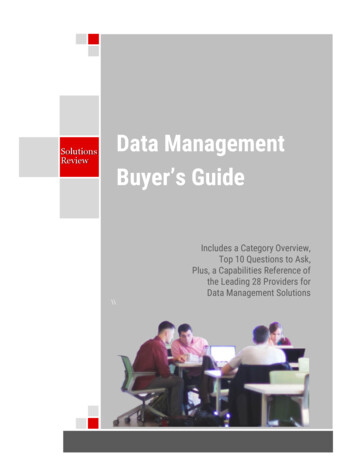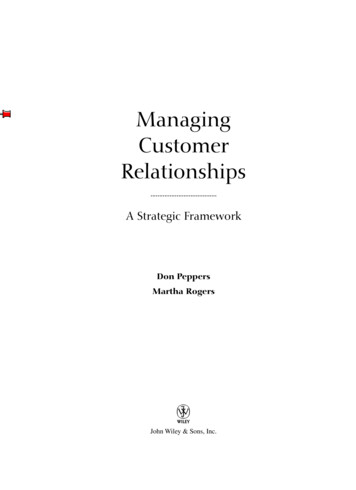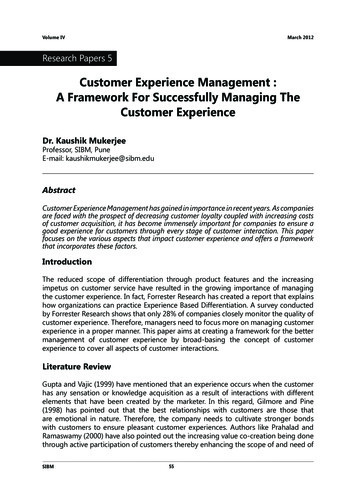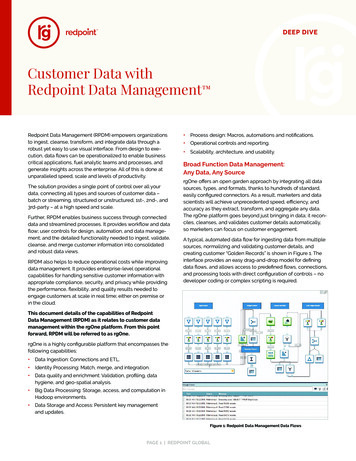
Transcription
DEEP DIVECustomer Data withRedpoint Data Management Redpoint Data Management (RPDM) empowers organizationsto ingest, cleanse, transform, and integrate data through arobust yet easy to use visual interface. From design to execution, data flows can be operationalized to enable businesscritical applications, fuel analytic teams and processes, andgenerate insights across the enterprise. All of this is done atunparalleled speed, scale and levels of productivity.The solution provides a single point of control over all yourdata, connecting all types and sources of customer data –batch or streaming, structured or unstructured, 1st-, 2nd-, and3rd-party – at a high speed and scale.Further, RPDM enables business success through connecteddata and streamlined processes. It provides workflow and dataflow; user controls for design, automation, and data management; and the detailed functionality needed to ingest, validate,cleanse, and merge customer information into consolidatedand robust data views.RPDM also helps to reduce operational costs while improvingdata management. It provides enterprise-level operationalcapabilities for handling sensitive customer information withappropriate compliance, security, and privacy while providingthe performance, flexibility, and quality results needed toengage customers at scale in real time; either on premise orin the cloud. Process design: Macros, automations and notifications. Operational controls and reporting. Scalability, architecture, and usability.Broad Function Data Management:Any Data, Any SourcergOne offers an open garden approach by integrating all datasources, types, and formats, thanks to hundreds of standard,easily configured connectors. As a result, marketers and datascientists will achieve unprecedented speed, efficiency, andaccuracy as they extract, transform, and aggregate any data.The rgOne platform goes beyond just bringing in data; it reconciles, cleanses, and validates customer details automatically,so marketers can focus on customer engagement.A typical, automated data flow for ingesting data from multiplesources, normalizing and validating customer details, andcreating customer “Golden Records” is shown in Figure 1. Theinterface provides an easy drag-and-drop model for definingdata flows, and allows access to predefined flows, connections,and processing tools with direct configuration of controls – nodeveloper coding or complex scripting is required.This document details of the capabilities of RedpointData Management (RPDM) as it relates to customer datamanagement within the rgOne platform. From this pointforward, RPDM will be referred to as rgOne.rgOne is a highly configurable platform that encompasses thefollowing capabilities: Data Ingestion: Connections and ETL. Identity Processing: Match, merge, and integration. Data quality and enrichment: Validation, profiling, datahygiene, and geo-spatial analysis. Big Data Processing: Storage, access, and computation inHadoop environments. Data Storage and Access: Persistent key managementand updates.Figure 1: Redpoint Data Management Data FlowsPAGE 1 REDPOINT GLOBAL
Extensive support for regular expressions (including regularexpressions in string transformations) and for building/classifying tokens and pattern matching based on regularexpressions.Basic read/write: access to flat and delimited text files, withsupport for single and multi-byte data with full Unicodesupport and EBCDIC, with or without EOL, and with anydelimiter and surround character. Logical processing functions including data filtering,contingent value processing, and data-based branching. Support for local and global variables that can be used insingle data flow projects and across data flow projects. Support for parsing structured files including XML and JSON. Traditional DBF files and proprietary DLD files, which providea highly compressed file format for high throughput, checkpoint restart, and indexed query/append.Conversion of data types and transliteration acrossUnicode code pages. Removal of non-printing characters (single and multi-byte).Data Read/WriteRedpoint Data Management provides the ability to read andwrite single and multi-byte data with full Unicode support froma variety of sources: Databases access: many database types are accessedusing native drivers and most others using OLEDB or ODBCdrivers. Supported databases include Microsoft SQL Server,Azure SQL Server, Azure SQL Data Warehouse, IBM Netezza,Teradata, Oracle, Sybase, Postgres/Greenplum, MySQL,DB2, AWS Redshift, AWS Aurora, Snowflake, Access/Excel,and others. EDI data formats: including X12, EDIFACT, Electronic HealthRecords and others. NoSQL / Document databases such as MongoDB andCosmos DB. Hadoop databases and file types such as HBase, Hive, Avro,and Parquet (see Hadoop section below). Message queues including IBM MQ, Kafka, AWS SQS, andAzure Service Bus. Salesforce CRM.Figure 3: RPDM includes an extensive set of transformation capabilitiesAll of the transformation functions within rgOne are availablein both automated expression building and in an expressionlanguage. This allows users to nest/stack functions as deeplyas desired without sacrificing usability or performance.rgOne also supports high performance sorting, joining andfiltering (including single step file splitting and identification ofunique records).Web ServicesRedpoint data management allows users to integrate the fullrange of ETL, data quality/hygiene and customer data integration functions with web-based data sources. RPDM web servicescapabilities allow for:Figure 2: RPDM supports a wide range of the commonly used extractand load typesTransformationrgOne includes an extensive set of data transformationcapabilities. This set covers the full range of functions neededto transform and integrate data from any source for use in anytarget. The set of functions includes: : More than 40 date/time functions that can be used totransform or synchronize date/time attributes. More than 30 numeric and arithmetic functions. More than 60 string transformation functions for managingtext, including managing unstructured block text, commentdata, and “white-space” analysis. Capturing session and cookie information to create securemulti-task (complex) service processes. Encoding session data in headers, URL parameters, XML,or JSON. Processing HTTP posts and gets, allowing for both pushand pull exchanges. Full support for OAuth2. Defining execution and retry strategy.Figure 4: RPDM Web ServicesThe platform allows service calls within any project or data flow.Additionally, rgOne jobs can be deployed as SOAP-based webservices with advanced web service load balancing capabilities.PAGE 2 REDPOINT GLOBAL
Solve Customer Identity ChallengesIdentity resolution helps marketers gain a better understandingof customers by building an accurate and usable representation of them (anonymous or known). This insight allowsorganizations to predict and shape customers’ behavior,improve retention, increase sales, reduce friction in thecustomer experience, and maximize customer profitability. Inaddition, identity resolution through rgOne supports digitalinteractions that are primarily real time. Accurate recognitionis the single most important step in providing a tailored andrelevant experience for the customer in their moment of truth.The customer data management capabilities within thergOne platform: Provides the most powerful set of advanced data quality,identity resolution, matching, and master data management capabilities available on the market today. Using itsadvanced probabilistic and deterministic matching (withmore than 375 built-in functions), marketers can easilyidentify, match, link, and de-duplicate files and standardizeand correct data for more than 200 countries.Deciphers and relates individuals, households, cookies,IP addresses, IoT smart devices, and more to form a clearand complete picture of every customer. Using rgOne,marketers can create and enhance a customer “GoldenRecord” – a singular, accurate, and continuously updatedview of each customer that is maintained with a persistentkey, in minutes, seconds, or on demand.Includes a full range of data quality and cleansing capabilities. These are native to the product. Users need notseparately license and integrate a data quality tool toperform normalization, validation, and probabilistic matchingalong with the ETL functions described above.The example Identity Management data flow below includesnormalization, validation, and probabilistic matching for name,address, email, and phone to produce accurate matchesacross a range of sources and interactions.Identity Matching ApproachrgOne handles matching with a broad set of capabilities: Out-of-the-Box Matching Tools for matching at thehousehold, person, address, email, URL, and account levelswithout coding or developing match algorithms. Probabilistic and Deterministic Matching that combinesstatistically based matching with customer data integrationbusiness rules to create highly accurate match results. Completeness and Accuracy with tools and referencedata to cleanse and standardize names, addresses, phonenumbers, and email addresses in North America and 240other territories. Alias Resolution for name-variance mapping (e.g. Lewis,Louis, Lew, and Lou or Street, St, and Str).Figure 5: Matching data flow handles validation, normalization and deterministic and probabilistic matchingPAGE 3 REDPOINT GLOBAL
Iterative Cycles mirror person/business natural changesand handle new data becoming available over time. Thisincludes support for adding records or breaking apartexisting person, household, or business groups. Performance and Scalability is a key requirement for thedeep and iterative matching. Redpoint has been benchmarked to process high volumes of data 500 percent to1,900 percent faster than leading alternatives. Flexibility, with multiple matching levels, from very tightmatches with close to zero over-matching rates for compliance uses to simultaneous looser matching for marketingor fraud detection.Address StandardizationrgOne includes tools to parse, standardize, correct, complete,and certify addresses from around the world. The followingoptions are available: US address standardization that is certified by the UnitedStates Postal Service, with certifications in Coding AccuracySupport System (CASS), Delivery Point Validation (DPV),Locatable Address Conversion System (LACS),and SuiteLink. Appending of Extended Line of Travel (ELOT) data, alsoknown as carrier walk sequence. Geocoding using US Census TIGER Geospatial directories. Canadian address standardization that is certified by CanadaPost with a certification in the Software Evaluation andRecognition Program (SERP). International addressing standardization based on relevantlocal laws/regulations. .Figure 6: RPDM address analysis and transformationName ParsingrgOne includes a full range of name parsing capabilities,including:: Splitting full names into component parts (including namefields that have been overloaded with multiple personssuch and John and Jane Smith). Standardization of name prefixes and salutations (e.g., Dr.,Mr., Mrs., the Honorable). Probabilistic gender assignment (based on census name/gender assignment). Business name processing, including keyword andalternative name identification. Adding custom names files to account for cultural namedifferences and known aliases.rgOne name parsing can be extended to include patternmatching for roles (e.g., guardian, beneficiary) and “extendeddata” (e.g., notes, deceased indicators, record references) thatare sometimes overloaded into name fields. Name parsing canalso be extended to account for name patterns and distributionfor international locations. This allows users to customize thename processing to account for regional and ethnic variancesand user specific data requirements.MatchingrgOne uses a mix of probabilistic and deterministic techniquesto easily identify, match, link, and de-duplicate files. Theplatform includes out-of-the-box consumer (B2C) and business(B2B) matching with highly configurable tools that combineflexibility and best practices into a single package.Figure 7: Redpoint matching automates keys, segments and reportsrgOne supports simultaneous matching across multiple matchlevels (tightness or looseness of matching) and multiple matchtypes (e.g. name/address, name/phone number, name/account number). Simultaneous matching allows differentmatch criteria and confidence factors to be specified for eachpass/comparison, allowing for matches to layer without overmatching or having to write complex integration rules.Duplication Handling Duplication HandlingrgOne can roll up duplicate records to master records basedon data quality/completeness, data frequency, or user specified rules. These capabilities support cross-matching datafrom multiple sources with common entities (e.g., customers,suppliers) that do not have shared keys. Other uses includegrouping account-level data at the person/ household/ groupor business level to create “rollups” or common keys; creatingunique records in files (de- duplication); and rolling up dataacross multiple records based on user specifications.Data Classification and StandardizationrgOne provides out-of-the-box standardization for other fieldtypes, including: Phone (North American and international, area-codevalidity, area-code state, letter-number conversion, etc.). Social Security Number formatting and validation(sequence validity, area and group validity); assignmentcannot be validated. Email format. Social media handle format (and validation via external webservice as provided by the various social media channels). URL format and URL encoding.PAGE 4 REDPOINT GLOBAL
Data ProfilingPersistent Key ManagementrgOne offers robust data profiling capabilities, including:rgOne includes tools that allow users to easily manage persistent keys – creating, updating, merging, and splitting as datachanges over time. Source validation tests input data against one or morespecified formats (data layout, type, values, etc.) for acceptance testing and flow control; matching is based on thepercentage of records that meet defined criteria and filescan be accepted or rejected in whole or in part. Profiling input data sources for counts (by value and null),uniqueness (by field or record), data characteristics (min/max, longest/shortest, etc.), and compliance with patterntemplates or masks (data type and data pattern). Table and column compliance with user-defined sets of rules(e.g., pattern templates and masks), range (by value or othercolumn), specific values (by value or another column), etc. Key constraints (e.g., uniqueness within a table or value/key constraints across tables), including support formulti-column or compound keys.Figure 8: RPDM ProfilingGeospatial AnalysisThe platform is designed to deal with the complexities ofconstant key persistence (new/additional records, recordsplits/ reassignment, historic key management, etc.) andhouseholding (new/additional persons, household breakapart, maintaining head-of-house across match-groups, etc.).Persistent keys can also be assigned at the group level andsource level, allowing customers to track performance atthese levels.Important capabilities and features relating to keymanagement include: Handling new/updated data sources (new/additional databeing added). Support for natural changes in household structure, including merging groups (such as marriage or cohabitation), newgroup members (such as births and adoptions), and splits(such as divorce or deaths). Managing persistent keys at the person, household, group,address, and business levels. Enforcing unique key constraints. Compiling master records from multiple sources based oncompleteness, frequency, and validation rules.rgOne provides many spatial analyses and transformations,including: Shapefile import/export. MID/MIF (MapInfo) import/export. Point-in-polygon (market penetration, political analysis,heat- map generation) analysis. Spatial join (territory overlap, productivity, flood plains).Find nearest neighbors (store location, service areas). Transform polygons to/from raw data lists (custom regionmanipulation logic). Spatial object operations such as inflate, cut, intersect,union, convex hull. Spatial summarize (aggregation of spatial objects). Grid cell (mapping of areas onto uniform grids for analysis).Figure 10: Persistent Key Support and Key MatchingProcess Automation and NotificationsrgOne allows users to automate both the processing andmonitoring of data management jobs and projects, resulting inhighly streamlined and effective operations.AutomationsWithin rgOne, users can build complex workflows (automations)that combine the various data-flow projects – ETL, data quality,customer data integration, and key management functions.Other automation capabilities include::Figure 9: RPDM geospatial analysis Scheduling jobs based on calendar, presence of files, orchanges to a database. Creating webs of interdependent jobs that are managedfrom a single control point. Executing external programs. Waiting for user review and acceptance. Transferring files via FTP. Determining source format and validity. Notifying users and operations of job outcomes.PAGE 5 REDPOINT GLOBAL
Automations are used to: Multi-server job distribution – Redpoint software can run ina centrally controlled environment with numerous processing nodes executing jobs. Execution monitoring and logging – All jobs can bemonitored by administrators and operators to determineboth overall progress and the actions of specific job steps.Developers and operators can drill down to the specificworking load (e.g., CPU, memory allocation, disk use) of eachcomponent in a job for monitoring and optimization. Command-line execution and web-service interfaces –Allow rgOne to be integrated into other operationalcontrol systems. Wait for files to appear in an upload directory, and automatically process them when they do. Break a long transformation process into smaller steps, soa single failure does not require a complete restart. Include other tools (e.g., compression, encryption, specialized file transfer tools, client proprietary data processes) inRedpoint processes. Integrate other tools through standard in-process datatransfer (e.g., XML, data pipes and APIs, structured data files). Let the user enter parameters to control execution at startupsuch as filenames, filter options, or report options. Suspend execution midway and let the user review and editdata directly, for data stewardship approval, special-casecorrections, and fuzzy-matching review.Reporting Loop over all files in a directory and run the same set ofsteps on each file/data feed. Validate a file against many possible formats, and when aformat matches, take appropriate action.A project execution log that tracks records read, processedby various steps, and written to various outputs (includingdatabase load counts, non-processed record counts, etc.). Aggregate and summary functions (e.g., number of recordsby source or by criteria, min/max values) that can either bewritten to reports or out to databases/data files or mergedback into the data processing stream. Creation of structured and cross-tab reports based ondefinable layouts and configurations, with support for concatenated or nested reports to create complex summariesof data at all phases from initial input to final output. Generation of reports and graphics based on Redpointprocessing without having to reprocess data in BI/reportingtools, or creation of XML feeds that can be directly used bythird party report tools. Specialty reports for data hygiene (e.g., address quality andaddress component reports) and customer data integration(e.g., match quality, match by source, duplication). Redpoint users maintain oversight of data management functions with summarization and reporting capabilities, includi
This document details of the capabilities of Redpoint Data Management (RPDM) as it relates to customer data management within the rgOne platform. From this point forward, RPDM will be referred to as rgOne. rgOne is a highly configurable platform that encompasses the following capabilities: Data Ingestion: Connections and ETL.
